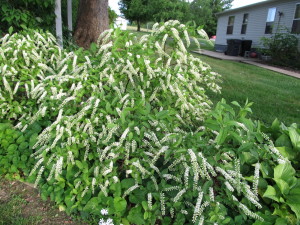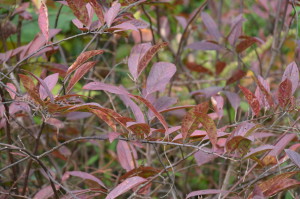Virginia sweetspire (Itea virginica) is a native shrub that touts showy white raceme flowers in late spring and brilliant reddish purple foliage in fall (USDA hardiness zones 5-9). Flowers are very fragrant and attracts hundreds of bees and other pollinators.
VA sweetspire excels in moist, humus-rich, mildly acidic soils (pH 5.2-6.5). In its native habitat, this rambling shrub is found growing adjacent to brooks and streams in woodland areas alongside other wildflowers and ferns.
For maximum flowering and intense fall leaf color, grow VA sweetspire in full sunlight and moist soil. It tolerates moderate shade and thrives in average soils. Mulch the ground around the shrub with 3 inches of pine straw, chips, nuggets or other organic material. Once established, usually after one year, this shrub is moderately drought tolerant. Fertilize in spring with a slow release organic fertilizer such as Osmocote™ or Nutrikote™ following package directions.
Hold off pruning until after flowering. Hold this suckering plant to its place and remove old spent flowers to maintain a tidy appearance. Insects and diseases rarely trouble VA sweetspire. If you notice spotting on the leaves, they will likely be harmless. Remove unwanted suckers any time of year. One or two may be dug up and replanted in another location. If suckers are left in place, VA sweetspire will form a wide colony.
Mature plant size is 3 to 6 feet tall and wide, depending on the cultivar. ‘Henry’s Garnet’ is the best-known and is widely grown cultivar at 5-6 feet high and 4-6 feet wide. It thrives in summer heat and winter cold and exhibits excellent flowering and fall color. Put your nose up close to pick up the delightful fragrance. Shorter growing ‘Little Henry’ is 4 – 5 feet tall. ‘Merlot’ grows 4 – 4 ½ feet tall with a deep-red fall leaf color. ‘Saturnalia’ is more upright branched with a standout fall color.



 Posted in
Posted in 
